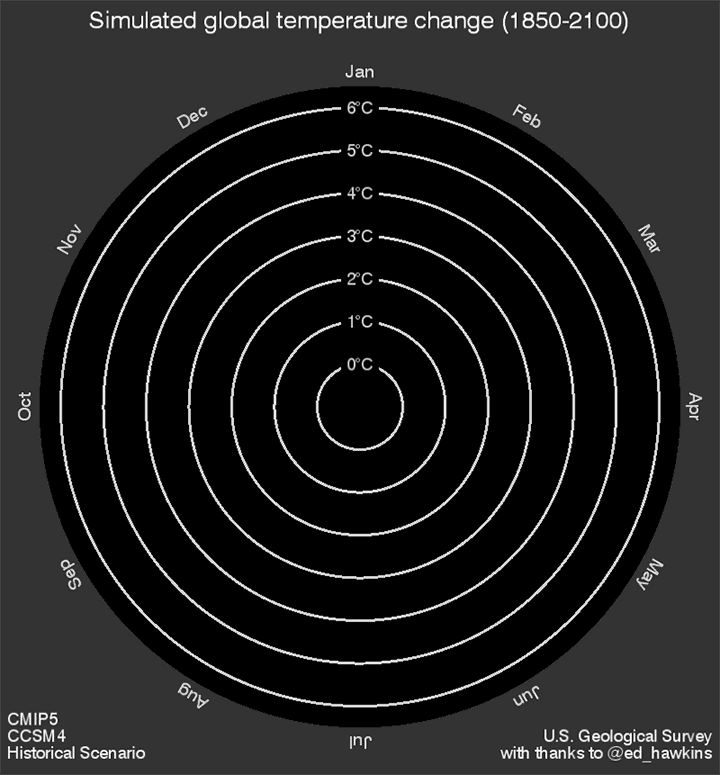News•May 31, 2016
The Temperature Spiral Has an Update. It’s Not Pretty.

By Brian Kahn
The temperature spiral that took the world by storm has an update. If you think the heat is on in our current climate, you ain’t seen nothing yet.
To recap, University of Reading climate scientist Ed Hawkins wrecked the internet a few weeks ago with a revolutionary new way to look at global temperatures. Using a circular graph of every year’s monthly temperatures and animating it, Hawkins’ image showed planetary heat spiraling closer to the 2°C threshold in a way no bar or line graph could do.
An update to the famous temperature spiral using future climate projections
Credit: Jay Alder/USGS

His tweet with the original graphic has been shared 15,000 times and it’s been dubbed the most compelling climate visualization ever made (sorry, landmarked Keeling Curve). The spiral’s popularity can be attributed in part to its hypnotic nature and the visceral way it shows the present predicament of climate change.
Hawkins’ graphic hints at the temperature spiral to come, but now a new addition brings what the future holds into stark relief.
RELATEDSee Earth’s Temperature Spiral Toward 2°C
These Paintings Turn Climate Data Into Art
Climate Data Meets the Funny Pages at xkcd
“Like a lot of people, I found Ed Hawkins' temperature animation very compelling because it details observed warming from 1850 to present in a novel way,” U.S. Geological Survey scientist Jay Alder said. “His graphic sets the context for looking at projections from climate models.”
So Alder used climate projections and stretched the spiral to its logical conclusion in 2100 when most climate model projections end. Using our current carbon emissions trends, it shows that things could get out of hand pretty quickly.
The world has been on the edge of the 1.5°C threshold — the amount of warming above pre-industrial levels that could sink many small island states permanently — this winter and early spring thanks to climate change and a strong El Niño. If the world continues on its current carbon emissions trend, it could essentially pass that threshold permanently in about a decade.
The 2°C threshold — a planetary “safe” threshold enshrined in the Paris Agreement — will likely be in the rearview mirror by the early 2040s as temperatures spiral ever higher. By 2100, every month is projected to be 5°C (9°F) warmer than it was compared to pre-industrial levels.
It’d be a world vastly different than today with sea levels up to 3 feet higher (and possibly more if Antarctica’s ice goes into meltdown), rapidly shrinking glaciers and highly acidic oceans. Those changes would have very real consequences for coastal cities, water resources and ecosystems across the planet.
Of course, Alder’s super spiral is only one possible future for the planet. Last year’s Paris Agreement could be a turning point where nations start to rein in their carbon pollution. While temperatures would likely still spiral higher because of warming that's already locked in, cutting carbon emissions now will at least make the spiral more manageable.
You May Also Like:
Africa’s Most Vulnerable Face an Even Hotter Future
Global Warming Threatens the World’s Special Places
America’s Sickest Wetlands Are in the West, EPA Finds
